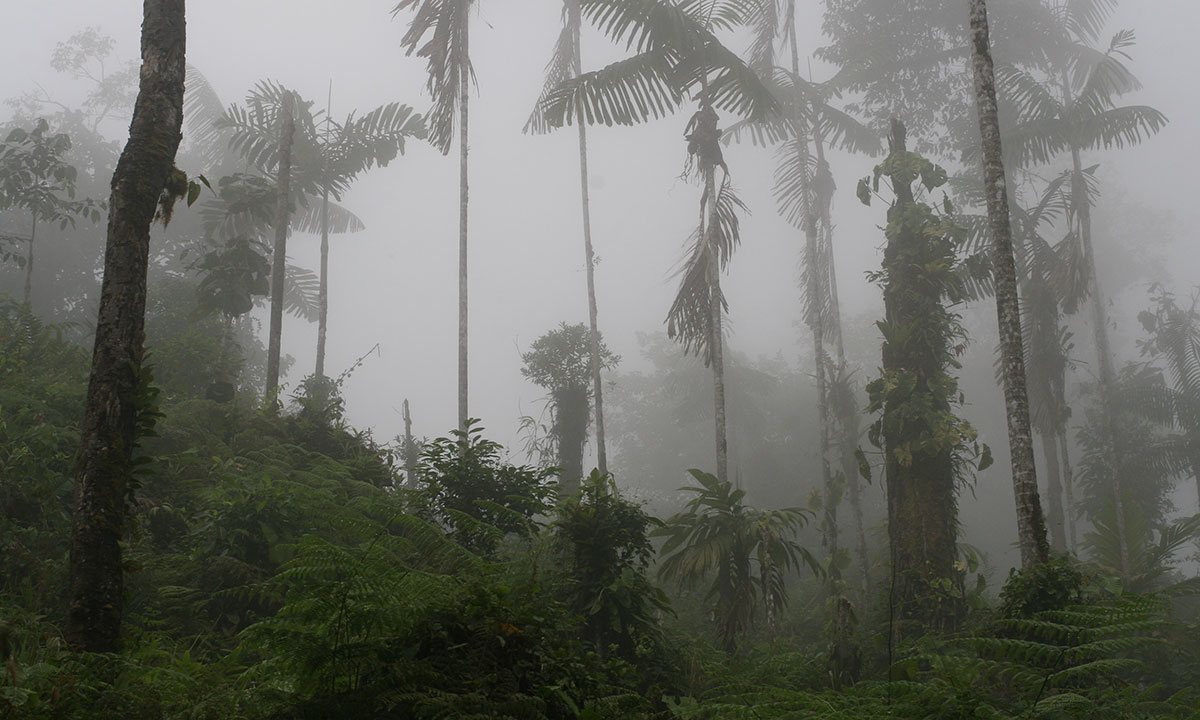BIO-GEEC: Measures to protect biodiversity in Ecuador

Countless previously unknown animal species, many of them endemic, live in the cloud forests of Ecuador.
© LIB, Nadine Dupérré
Countless animal species live in the cloud and tropical forests of Ecuador but most of these species remain poorly known although their habitats are shrinking rapidly. The German-Ecuadorian research project BIO-GEEC, with the participation of the Leibniz Institute for the Analysis of Biodiversity Change, Hamburg (LIB), is establishing measures to preserve and restore the ecosystems. In close cooperation, researchers from different disciplines and research institutions in Ecuador and Germany have taken a major step toward biodiversity monitoring and protection in parts of Ecuador in the first phase of the project.
Ecuador is one of the most biodiverse countries in the world and is vested within two biodiversity hotspots, the Pacific Choco region and the Andes. The proportion of endemic species is particularly high in all ecoregions of the country. However, flora and fauna suffer extremely from deforestation and a strong fragmentation of natural habitats. Where species-rich forests once thrived, plantation and agriculture dominate the landscapes today. Within the framework of the German-Ecuadorian Biodiversity Consortium (BIO-GEEC), a basis for comprehensive conservation measures has been created over the past three years. The first research projects have been implemented and scientific infrastructures have been established.
Thanks to BIO-GEEC, a close-knit German-Ecuadorian network with nine participating research institutions is now committed to ecosystem research, environmental protection and applications in sustainable landscape use. Further frameworks for consumer protection, customs work and health care are currently being created. This network is being expanded by young Ecuadorian scientists who are trained in scientific methods and graduate within the framework of the project. With them, knowledge flows into companies and the research community, government institutions and policymakers.
“We have achieved a lot in these three years and hope that it will continue,” Danilo Harms, section leader arachnids at LIB, sums up. Working alongside botanists from the Nees Institute of the University of Bonn, who primarily study the highland vegetation systems of the Andes, he has advanced research and research infrastructure in the field of arachnids in Ecuador, together with Nadine Dupérré, Collection Manager Arachnology, and Lars Podsiadlowski, Scientific Manager of the Molecular Laboratory at LIB.
Using DNA barcoding and methods of morphological identification, the German and Ecuadorian scientists involved in the project created a database of the arachnids (spiders, scorpions and their kin) of Ecuador. This can be used for applied projects by researchers, students, government agencies and universities in Ecuador. In addition, DNA sequences and photos of the animals are made available through the newly established EcBioDiv (Ecaudorian Biodiversity) web app.
By recording the arachnid diversity across several Ecuadorian ecosystems, the researchers hope to gain a better understanding of the variety of species and their habitats and thus contribute to nature conservation in the country. At the same time, they have laid the groundwork for practical applications, such as arachnid venom analyses. As part of the project a biobank for venom samples has been established in Ecuador and venom samples for some important species will be analysed with biochemists at the University of Hamburg in the future.
For faster and more cost-effective genetic analysis, the German partners provided the Ecuadorian institutes with sophisticated pipelines for DNA barcoding of plants and microbes as well as animals. In total, the scientists collected and identified 2,500 arachnid samples as part of BIO-GEEC, characterized them using DNA barcodes and morphology, and described seven new tarantula species during the first phase of the project with more species to follow soon.
Three arachnid species that produce highly dangerous venoms for humans have already been widely researched, such as the brown recluse spider (Loxosceles, blood toxins), the banana spiders (genus Phoneutria, neurotoxins) and the thick-tailed scorpion (genus Tityus, neurotoxins). However, now other venoms have been collected that have not been investigated before. Scientists took a total of 300 venom samples from 20 different scorpion and spider species during the project. They will be analyzed by biochemists at the University of Hamburg.
“Close cooperation between researchers from different disciplines and countries is the project work of the future,” Harms emphasizes. “Experts from Ecuador and Germany have worked closely together under one objective, each contributing and sharing their specialized knowledge. We have laid the groundwork for future joint research and better protection of habitats in Ecuador.”
BIO-GEEC is funded by the “German Academic Exchange Service” (DAAD) and the “Deutsche Gesellschaft für Internationale Zusammenarbeit” (GIZ) and is implemented in close cooperation with the Ecuadorian “Instituto Nacional de Biodiversidad” (INABIO).
Contact:
Leibniz Institute for the Analysis of Biodiversity Change, Hamburg
Dr. Danilo Harms
Section Head Arachnology, Curator of Arachnids, Myriapods and Basal Arthropods
E-mail: d.harms@leibniz-lib.de
Nadine Dupérré
Collection Manager Arachnology
E-mail: n.duperre@leibniz-lib.de
Press contact
Mareen Gerisch
Head of Communication & Press
E-mail: m.gerisch@leibniz-lib.de







